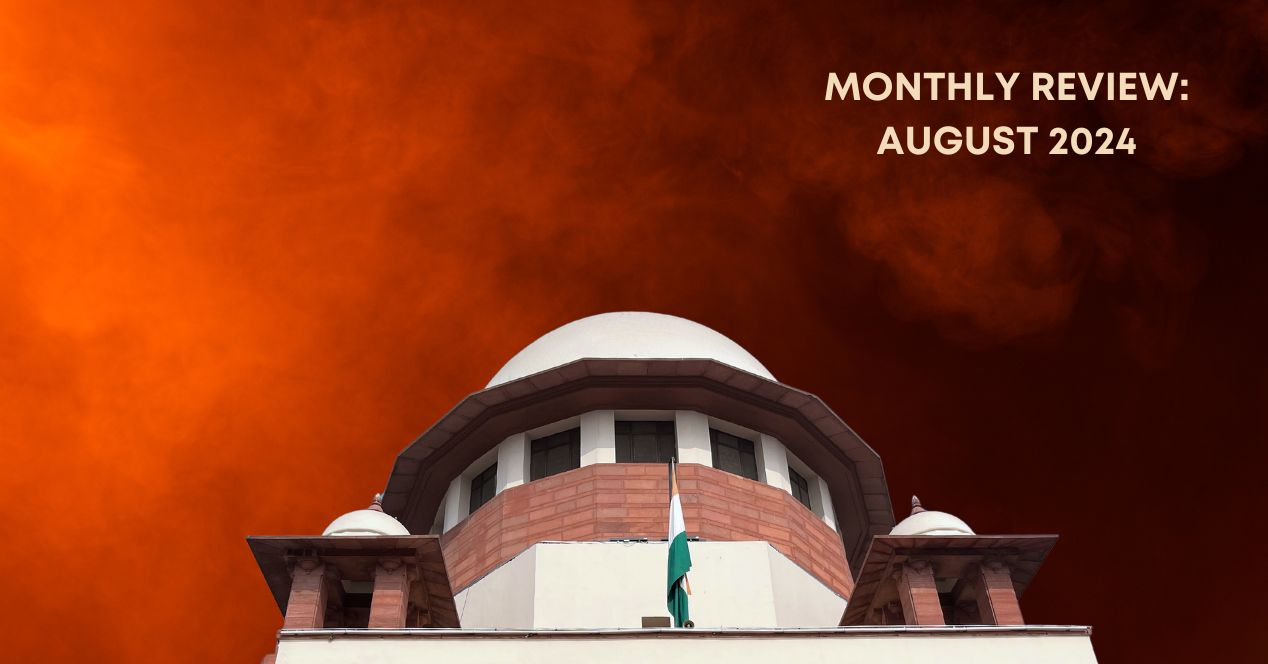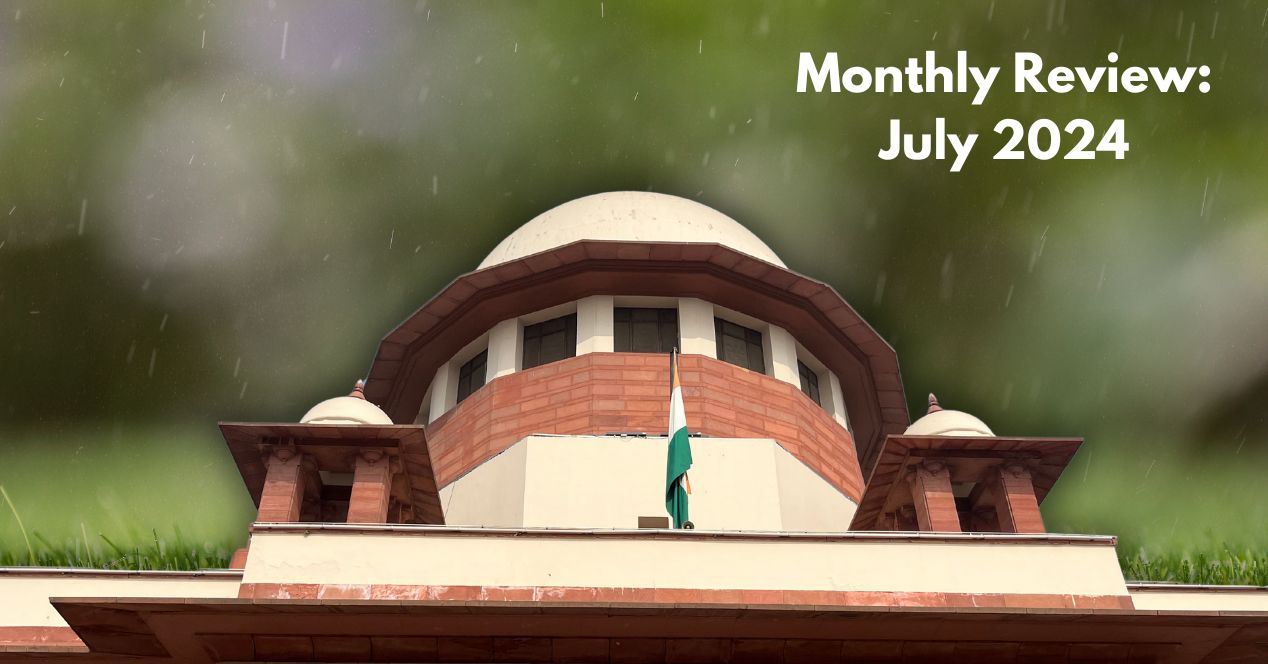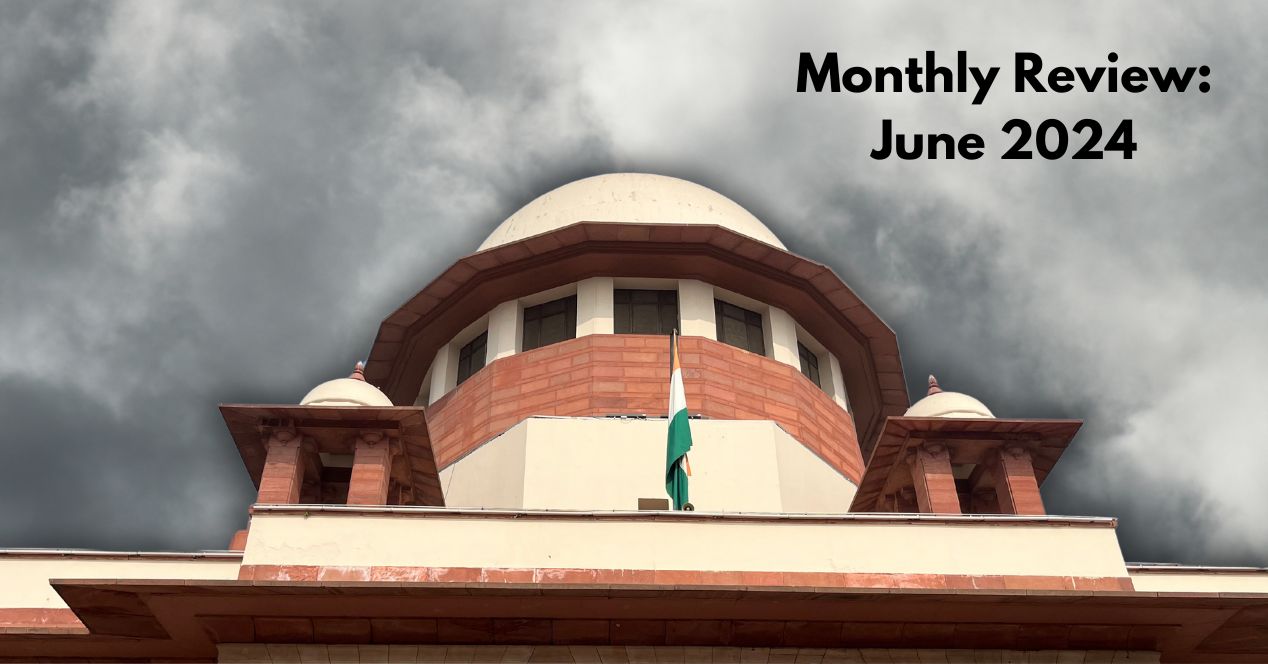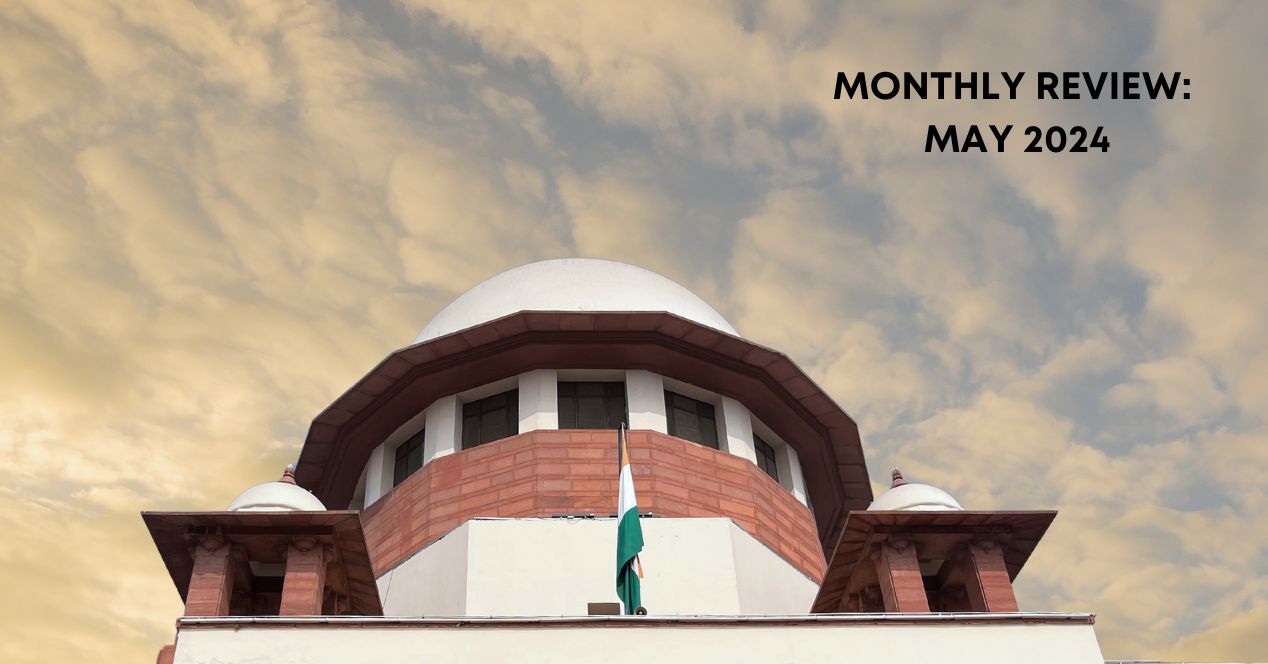Analysis
Monthly Review: September 2024
In September, the Court granted bail to two state ministers and heard cases on the R.G. Kar incident, bulldozer demolitions and child rights
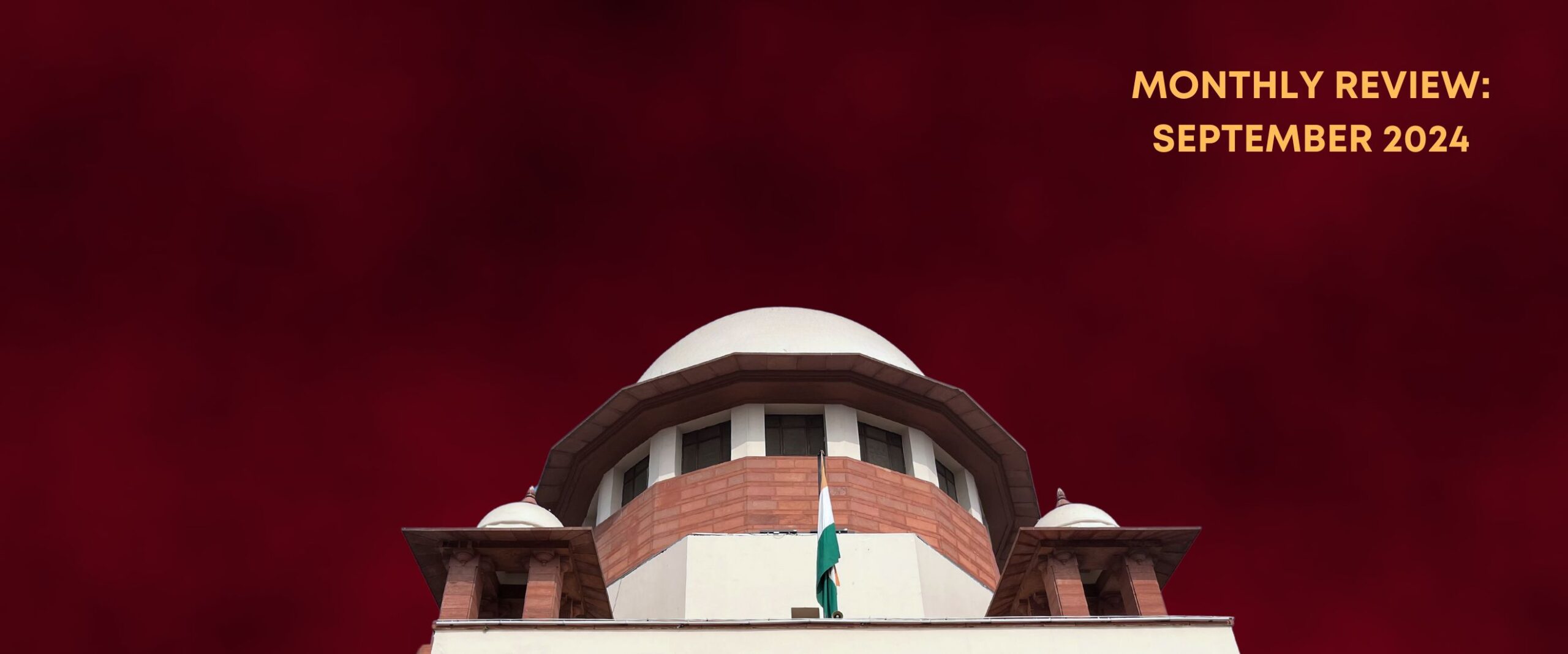
It is when the winds of autumn blow in that people ask that question that American band ‘Earth, Wind, & Fire’ has been asking since 1978: “Do you remember the 21st night of September?”
Here at SCO, we remember 21 September very well, as it was the date we published our PMLA timeline. Earlier that month, the Court had granted bail to Jharkhand CM’s aide Prem Prakash in a PMLA case. The Prem Prakash decision is crucial as the Court took another step away from its strict interpretation of the PMLA in Vijay Madanlal (2022). It declared that “bail is the rule and jail is the exception,” prompting us to wonder if the winds of change in PMLA jurisprudence were blowing.
September also saw several other noteworthy Supreme Court decisions and events. In this review, we have picked out the most important ones to remember.
Kejriwal gets bail in CBI case
On 13 September, a bench of Justices Surya Kant and Ujjal Bhuyan granted bail to former Delhi Chief Minister Arvind Kejriwal from his arrest by the Central Bureau of Investigation (CBI). The CBI had arrested Kejriwal on 25 June under charges of corruption under the Prevention of Corruption Act, 1988 (PCA) for his alleged involvement in the Delhi Liquor Policy scam.
Both judges agreed that Kejriwal’s continued imprisonment violated his rights under Article 21 of the Constitution. They noted that with up to 224 witnesses and many documents that needed assessment by the Court, any potential trial would take a long time to conclude. In the interim, Kejriwal need not remain behind bars. The bench also directed that Kejriwal had to adhere to certain bail conditions: paying a Rs. 10 lakh bond and not saying anything about the CBI case.
However, the judges disagreed on whether the CBI’s arrest was valid. Justice Kant took the side of the CBI, saying that the arrest followed the procedure under Section 41A of the Code of Criminal Procedure (‘CrPC’). Departing from his colleague, Justice Bhuyan held that the arrest was not valid as the CBI had only thought of arresting Kejriwal after he was granted bail in his ED case.
Court continues hearings on Kolkata rape and murder case
In September, the Supreme Court continued to hear the K.G. Kar Medical College rape and murder case. The Court had taken up the case suo moto in August and has heard the case five times so far. September saw three hearings.
On 9 September, the Court ordered that accommodations be provided to the Central Industrial Security Force (CISF) officers, sent to secure the premises of the hospital, so that they did not have to travel from the CISF cantonment 2.5 hours away. The Court also told protesting doctors to go back to work. Hoping to address the root cause of the protests, they directed the state government to install more CCTV cameras and asked the police to deal with complaints about doctor safety. The Court warned doctors that protests should not come at the cost of their duties as healthcare providers.
On 17 September, Senior Advocate Kapil Sibal mentioned that women lawyers in the chambers were receiving threats of violence, which he attributed to the live streaming of the hearings. While Chief Justice D.Y. Chandrachud was sympathetic, he stated that live streaming had to continue as a matter of public interest. The Court also directed Wikipedia to remove the name and image of the victim from its online content in order to maintain the victim’s privacy and dignity. Perhaps the largest issue from this day was a notification passed by the West Bengal Government, which tried to restrict women doctors from working more than 12-hour shifts or working at night. Chief Justice Chandrachud said that while security was important, it should not come at the cost of equal opportunities for women, which they were being denied by restricting their right to work.
The Court heard the case for the fifth time on 30 September. After reviewing the status of the security measures implemented by the state government, the judges questioned why the progress was so tardy. The Court also addressed the concern of doctors’ associations that several people involved in the incident continued to work at the hospital.
Bail for Balaji in the second major bail hearing of the month
After Kejriwal, the Court granted bail to another state minister. This time, it was former Tamil Nadu Minister of Transport V. Senthil Balaji. Justices Abhay Oka and Augustine George Masih used similar lines of reasoning as the judges in the Kejriwal CBI bail case—that Balaji had been in jail for too long with no trial in sight. In Balaji’s case, a trial seemed to be even further beyond the horizon than Kejriwal’s, as Balaji had three FIRs filed against him, one of which contained the names of 2,000 accused individuals and 550 witnesses.
Like with Kejriwal, the Court held that Balaji’s rights under Article 21 were also violated. The Court used this opportunity to set out a list of factors to determine whether an accused individual was being held for a reasonable amount of time. These are: the maximum and minimum sentences for the offence, the statutory provisions under which the accused is being held, whether that statute provides ‘stringent conditions’ for bail and any other time limit the statute provides for the completion of the trial.
Supreme Court clarifies scope of ‘child pornography’ and POCSO Act
High Courts across the country were split on whether the viewing, possession, and storage of child pornography was a punishable crime under the Protection of Children from Sexual Offences Act, 2012 (POCSO Act). On 23 September, the Supreme Court answered in the affirmative, overturning a Madras High Court decision from 2024.
The Supreme Court noted that three different offences could be found in the POCSO Act, outlined in Sections 15(1) (failure to delete, destroy, or report child pornography in the possession of an accused), 15(2) (actual transmission, display or distribution of the material), and 15(3) (storage or possession of material with commercial intent). The Court then interpreted 15(1) as punishing mere possession, unless and until the accused has deleted or destroyed it.
Additionally, the Court noted that Section 30 of the POCSO Act states that courts should presume that the accused had a culpable state of mind. Therefore, the burden of proof is on the accused to prove that they are innocent. For a 15(1) offence, the prosecution only has to show the accused had possession of the material and did nothing to get rid of it.
Supreme Court accepts Karnataka HC judge’s unconditional apology
In June 2024, a Karnataka High Court judge made headlines after calling a majority-Muslim area in Bangalore “Pakistan.” In August, the same judge made “objectionable remarks” about a woman advocate in his court. The Supreme Court stepped in to exercise its suo moto powers on 20 September. After taking note of the High Court judge apologising for his remarks, the Court closed the case on 25 September.
Brief as the case’s proceedings were, the embarrassment had swelled enough for the Karnataka High Court to pass an interim order preventing clips of the High Court from being used and stopping its live streaming on the High Court’s YouTube channel. But when Chief Justice Chandrachud was approached by Attorney General R. Venkataramani over what to do about the now-infamous clips, the Chief Justice replied that suppressing the court’s proceedings would not be a solution.
Court hears arguments on bulldozing the houses of accused individuals
Illegal demolitions of houses has been a frequent topic of discussion in the Supreme Court’s chambers over the past few years, and the topic reared its ugly head again in September. The Jamiat Ulama I Hind’s petition on bulldozer action was heard twice last month.
At a hearing on 2 September, Justice B.R. Gavai questioned how a person’s house could be demolished for the sole reason that he was charged with a crime. The bench suggested implementing pan-India guidelines for bulldozer actions. On 14 September, the Jamiat Ulama I Hind suggested some guidelines, which would require a notice of demolition to include the legal provisions under which the demolition was taking place, and the ability to appeal the decision to demolish.
On 17 September, the Court returned to the topic after a house was demolished despite the Court’s previous comments. Solicitor General Tushar Mehta attempted to justify the demolition, saying the accused had been on notice of the demolition since 2022 and that they had engaged in criminal activity since then. The bench, however, passed an order saying that no demolition could take place until the Court took the matter up again on 1 October.
At the end of the month, the United Nations called bulldozer demolition an aggravated form of human rights violation and suggested that the Supreme Court submit its own pan-India guidelines.
Court chambers the venue for discussion on Fundamental Duties?
Coming part and parcel with the Fundamental Rights of the Constitution are the oft-forgotten Fundamental Duties found in Section 51A. On 11 September, the Court heard arguments over whether these duties could be enforced against Indian citizens.
An essential argument for the enforcement of these duties is that the Constitution seems to put them on equal footing as its other enforceable sections. Had these duties not been enforceable, said Senior Advocate Ranjit Kumar, then they would have been included in the Directive Principles of State Policy section, which was clearly meant to be aspirational.
The Court seemed less optimistic about enforcement measures being implemented. Justice Sanjiv Khanna mentioned that the Court could not force Parliament or states to adopt laws enforcing duties. He also noted several laws that already had fundamental duties integrated into them, such as Indian Penal Code, 1860.
The Court will hear more arguments on fundamental duties in November.
Celebrating 75 years of the Supreme Court
In September, we published two new stories and a video in our special series commemorating 75 years of the Supreme Court.
From Lady Chatterley’s Lover to Salman Rushdie, the Supreme Court has had a complicated history with banning books that the public views as incendiary and risque. In his essay, author Salil Tripathi writes that the real decisions on book bans are taken in bureaucratic offices, city streets and village squares. Read it here.
Justice Hima Kohli’s retirement on 1 September left just two female judges at the top court. In fact, the Supreme Court has had a tenuous relationship with adding women to its ranks since its founding. Associate editor Gauri Kashyap chronicles it here.
Ever wonder how cases get allocated to different benches? While it isn’t as arbitrary as flipping a coin or spinning a wheel (hopefully), the process of bench allocations by the Chief Justice as the Master of Roster is still a mystery. SCO’s founding editor Sudhir Krishnaswamy and assistant editor Advay Vora did a deep dive into the rostering system under current Chief Justice D.Y. Chandrachud and his predecessor CJI U.U. Lalit, making a case for a publicly defensible rostering rationale. Read it here.
But those aren’t all! SCO started publishing pieces in this special series all the way in June. To read them, click here.

